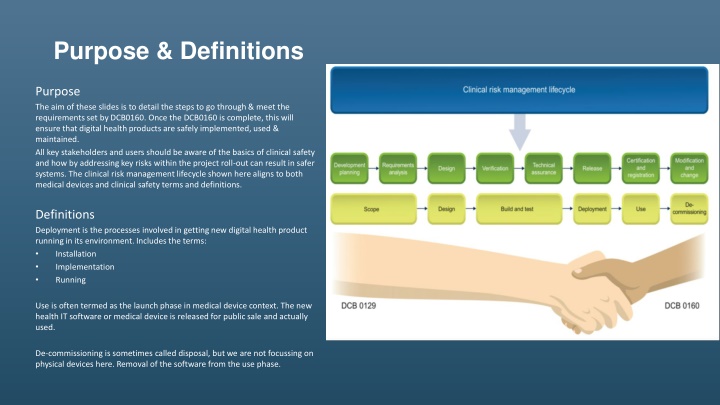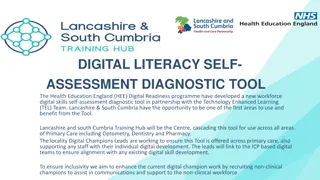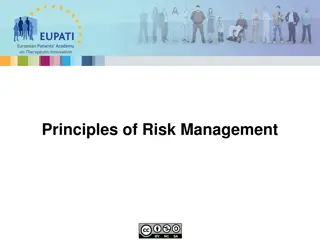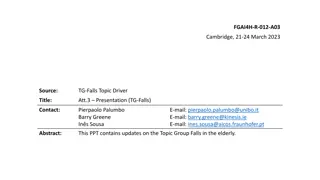Clinical Risk Management in Digital Health: Steps and Requirements
Detailing the steps required to meet the standards set by DCB0160 for the safe deployment, use, and maintenance of digital health products. Key activities include reviewing supplier documentation, appointing a Digital Clinical Safety Officer, conducting risk assessments, and producing essential reports. Compliance with standards such as DCB0129 is crucial in ensuring clinical safety in health IT systems.
Download Presentation

Please find below an Image/Link to download the presentation.
The content on the website is provided AS IS for your information and personal use only. It may not be sold, licensed, or shared on other websites without obtaining consent from the author.If you encounter any issues during the download, it is possible that the publisher has removed the file from their server.
You are allowed to download the files provided on this website for personal or commercial use, subject to the condition that they are used lawfully. All files are the property of their respective owners.
The content on the website is provided AS IS for your information and personal use only. It may not be sold, licensed, or shared on other websites without obtaining consent from the author.
E N D
Presentation Transcript
Purpose & Definitions Purpose The aim of these slides is to detail the steps to go through & meet the requirements set by DCB0160. Once the DCB0160 is complete, this will ensure that digital health products are safely implemented, used & maintained. All key stakeholders and users should be aware of the basics of clinical safety and how by addressing key risks within the project roll-out can result in safer systems. The clinical risk management lifecycle shown here aligns to both medical devices and clinical safety terms and definitions. Definitions Deployment is the processes involved in getting new digital health product running in its environment. Includes the terms: Installation Implementation Running Use is often termed as the launch phase in medical device context. The new health IT software or medical device is released for public sale and actually used. De-commissioning is sometimes called disposal, but we are not focussing on physical devices here. Removal of the software from the use phase.
Background What is DCB 01601? This standard provides a set of requirements suitably structured to promote and ensure the effective application of clinical risk management by those health organisations that are responsible for the deployment, use, maintenance or decommissioning of Health IT Systems within the health and care environment. Organisations who implement health IT systems undertake a formal clinical risk assessment and evidence the measures which have been put in place to mitigate risk relating to the implementation and use of the health IT system. To comply with the standard, an organisation needs to undertake a formal risk assessment on the product and produce three documents summarising the outcome; the Clinical Risk Management Plan, Hazard Log and Clinical Safety Case Report. The risk assessment needs to be carried out before a system goes live. What is DCB 01292? The DCB0129 is the clinical risk management standard which manufacturers of health IT systems and apps need to comply with. This information standard is published under section 250 of the Health and Social Care Act 2012. This standard provides a set of requirements suitably structured to promote and ensure the effective application of clinical risk management by those organisations that are responsible for the development and maintenance of Health IT Systems for use within the health and care environment. To comply with the standard, an organisation needs to undertake a formal clinical risk assessment on the product and produce three documents summarising the outcome; the Clinical Risk Management Plan, Hazard Log and Clinical Safety Case Report. The DCB 0129 standard is supplementary to the requirements of the NHS Information Governance Toolkit and the Medical Device Directive/Regulation. SOURCE: 1. DCB 0160: Clinical Risk Management: its Application in the Deployment and Use of Health IT Systems 2. DCB0129: Clinical Risk Management: its Application in the Manufacture of Health IT Systems
DCB0160 - Priority activities What are the minimum clinical risk management activities to implement our digital health product? Review Supplier 1 Clinical Risk Documentation 3 Go No Go Checkpoint 5 Receive DCB0129 docs Review with supplier Request amendments Plan for additional clinical risk activities Project Initiation Appoint a Digital Clinical Safety Officer (CSO) - suitably trained and qualified. Assess compliance obligations for DCB0160, obtain supplier DCB0129 compliance & CSO evidence; add reference in contract & Project Initiation Document (PID). Assign project staff suitable for ongoing clinical safety activities, appropriate to scale, complexity and level of risk of the release. Assign ownership of hazards Update Hazard Log Create Clinical Safety Case Report Create Hazard Log Identify stakeholders & invite Run workshop Review documents Get approval Post-release activities 6 4 Clinical Risk Actions Clinical Risk Workshop 2
DCB 0160 how this connects together Clinical Safety activities relating to the health organisation decisions & project team: Project Management provides control over the health IT deployment and execution of clinical safety activities throughout Senior leadership provide overall governance and control Testing gives us assurance evidence that the digital health product system works as intended Communications & Training help to avoid human factors issues often seen with the inadequate engagement of users Integration & Infrastructure teams provide assurances and evidence that the health IT system can be supported within the health organisation from a technical point of view Data Quality provides evidence that benefits and clinical outcomes are met
Typical Health Organisation project team Health Organisation Role(s) Responsibilities Health Organisation Deliverables Work-stream, Person or Team Project Direction Area Project Overall direction of the project Manage and oversee project finances Establishment of Project Board Provide assurances and updates to leadership team Governance Establishment of the Project Team Project Reporting Highlight Reports Finance Reports Engage with the Clinical teams regarding the deployment of the health IT system Chief Clinical Information Officer (CCIO) Clinical link between Health Informatics and Clinical specialities or departments Provide clinical steer and project leadership Project Governance Seek assurances that patient safety is not compromised Leadership Change Management Project Reporting and Finance Finance Lead Oversee financial spend Provide support and assistance to the Project Director and Project Manager to ensure that budget is controlled Monthly finance report Business As Usual (BAU) Roles accounts and support Oversee the creation and management of roles and accounts BAU Training material for BAU support Project Delivery Standard Operating Procedures for BAU Support Cascade messages and training to the wider Health Organisation Teams; Change request process Form part of the key decision-making team in defining new processes and procedures Standing Operating Procedures (SOPs)
Typical Health Organisation project team Health Organisation Role(s) Responsibilities Health Organisation Deliverables Work-stream, Person or Team Testing Area Project Governance Oversee the User Acceptance and Technical Acceptance Testing including providing evidence of outcomes Coordinate the testing and validation of the solution for all testing activity including providing evidence of outcomes; Test Strategy Test Plan Project Delivery Test Scripts Provide clear guidance and support to the Project Director and Manager on best practice for testing; Testing Test Outcome Report(s) Log all test issues. Product Assurance PID and Detailed Implementation Plan Project Management Day-to-Day Project Management Monitor project against plan, scope and deliverables Project Governance Project Closure Report, Lessons Learnt Report Management and maintenance of Project Risks and Issues Project Risk Log, Highlight Reports Project Reporting Gateway/ End Stage Reports Management of each stage and escalation, if required A fully configured and stable solution Project Delivery Ensuring the undertaking of clinical safety requirements in line with the Clinical Risk Management of Health IT Systems Policy and DCB160 standards Deployment into Early Adopter Deployment and use of health IT system across the Trust Establishment of clinical processes using the new health IT system Data Quality Reporting
Typical Health Organisation project team Health Organisation Role(s) Responsibilities Health Organisation Deliverables Work-stream, Person or Team Area Communications, Engagement & Change The management and transition of change within the Trust encompassing stakeholder engagement Direct the overall Change Management activities from the existing ways of working to the new, future state Project Governance Change Management Strategy and Plan Stakeholder Engagement Strategy including a complete stakeholder analysis and influence/impact grid Stakeholder Engagement Plan Ensure that key messages are in line with various other activities and functions, against the deployment plan Project Delivery Stakeholder Engagement Audit Reports Engagement Materials Updated Trust Policies and SOPs Establishment of various Advisory Groups (Clinical, Operational and Non-Clinical) Process Mapping Executive Sponsorship Chief Information Officer Provide strategic context to the project. Project Governance Gateway Sign off Senior Responsible Owner Ensure clinical safety officer responsibilities are upheld. Cycle(s) Sign off Executive Nurse Provide project steer, guidance and leadership Medical Director Remove barriers, as and when they arise
Typical Health Organisation project team Health Organisation Role(s) Responsibilities Health Organisation Deliverables Work-stream, Person or Team Training Area Project Governance The management and delivery of effective training Delivery of training using various training approaches; Training Strategy Training Plan The development of eLearning material Training Materials including eLearning Project Delivery Delivery of training The development of learning material; The development of a Training Strategy and Plan Validation of the environments and infrastructure against the original requirements Technical Integration & Infrastructure Ensure that the solution is technically stable and that monitoring is place for the various feeds Project Delivery Validation of Live, Training and Test Environments Interfaces & Integration Establish monitoring and reporting Technical Architecture Document Ensure that the Trust has the appropriate hardware to function Standard Operating Procedure for the management of the environments
Typical Health Organisation project team Health Organisation Role(s) Responsibilities Health Organisation Deliverables Work-stream, Person or Team Area Data Quality The management of the digital health record Ensure that through the transition, the digital health record is maintained Project Delivery Standard Operating Procedures for the Data Quality Team Draft and agree SOP s for the Data Quality Team; Training of the Data Quality Team Training of the Data Quality Team; Form part of the key decision making team in defining new processes and procedures Manufacturer Provide the health IT solution Work with the Health Organisation Project Delivery Detailed Implementation Plan Test Strategy and Plan Technical Architecture Document Exceptions Reports A fully configured and stable solution
DCB 0160 typical digital health hazard Hazard Identification & Initial Assessment Harm Hazard Effect Possible Causes Existing Controls Incorrect Clinical Diagnosis Incorrect patient data uploaded Patient receives incorrect diagnosis Staff member may inadvertently enter an incorrect patient number. Staff member may incorrectly identify a patient. Insufficient training of staff. Out of Date or incorrect Standard Operating Procedures. Digital health system not operating as intended or designed. Staff to check Patient ID to ensure they record against correct patient. Current roles and responsibilities for clinical and non-clinical staff are well defined. There is a Duty of Care & correct identification of patient at the point of care. Current staff should have a familiarity and professional accountability on the use of health IT systems, including those that are new to the organisation.
DCB 0160 typical hazard mitigation and control Hazard Controls Technical Assurance Training Business Process All relevant Standard Operating Procedures must be approved and tested to ensure they represent the clinical workflow to be implemented and used. Manufacturer All staff should be trained on the system prior to implementation. Digital Health product manufacturer must provide a stable solution that is fit for purpose. Technical Assurance should incorporate a test environment representative to the health IT system to be implemented. This allows new and existing users to check procedures work and deliver expected results prior to implementation. Use of floor walkers who are experienced to provide "expert" on-the- spot guidance should be available. Digital Health product is compliant with clinical safety standards and have the appropriate clinical safety documentation available. Training records and knowledge resources should be maintained, and be representative of the health IT system being used: Training Strategy Training Plan Training Materials including eLearning Delivery of training Technical Integration The following activities must occur prior to deployment: Validation of Live, Train and Dev Environments. External Partners must provide input to the following deliverables for safe delivery: 1. Implementation project plan 2. Test strategy and plan 3. Lessons learnt report 4. Highlight reports 5. Gateway reviews Interfaces to other systems tested. Testing of the health IT system Test Strategy, Test Plan, Test Scripts, Test Outcome Report(s)
Worksheet _____________ of __________________ Date: Section / Task Description of section or task to be analysed (including inputs, outputs, descriptions of activities, resources (people, drugs, equipment) , controls and other comments Team Consequence seldom changes! Focus on likelihood. No. Hazard Effect Hazard Name Harm Possible Causes Existing Controls Initial Risk Rating Additional Controls Residual Risk Rating C L R Design Test Training Business Process Change C L R 1 Implementation / Deployment 2 3 4 SoP, Workflow, Clinical / Patient Use 5 6 Mitigation Start with the hazard name and then think about the effect this may have, then move over to harm and think about the harm to the patient directly. All controls must be simply summarised as to why they provide the control. References to evidence where more detailed explanation can be found must be provided.
Results extract of typical AI / ML hazard log Hazard Identification & Initial Assessment Harm Effect Hazard Possible Causes Undetected software failure or data error causes algorithm to incorrectly or inaccurately process input data. Resulting in unexpected system behaviour and processing delays. Health organisation infrastructure does not meet the minimum required specification for the non-functional / volumetric performance of the system. CT scores a CT scan and generates output; virus corrupts files; results are displayed incorrectly; physician chooses wrong treatment. Undetected software failure or data error causes algorithm to incorrectly or inaccurately process input data. Output results are inaccurate providing false positives or false negatives and/or incorrect classification of fresh hypo density. Coverage RSD does not detect inferences for border cases and outliers.. Underrepresent Minority populations not sufficiently represented in the synthetic dataset. Unwarranted The resultant dataset creates inferences unwarranted in the real data. Lack of consistency in the system behaviour. Concept Drift, Brittleness. Lack of integrity of system and vulnerability to security attack. Digital Health Intervention failure Delay in the diagnosis and on-going treatment of the patient Software failure or data error Hardware or cloud services error Digital Health Intervention failure Delay in the diagnosis and on-going treatment of the patient File corruption - including displayed image Digital Health Intervention failure Patient receives incorrect diagnosis. Digital Health Intervention failure Software failure or data error Patient receives incorrect diagnosis. Inability to evidence overall end to end AI safety for the system. Digital Health Intervention failure Patient receives incorrect diagnosis
Summary and next steps The effectiveness of Clinical Safety compliance is dependent on the following: Manufacturer co-operation and compliance to DCB 0129 and any other relevant standards (e.g. Medical Device Regulations) Project team awareness of clinical safety Clinical engagement Communication within the project Results: This guidance document Sample hazards taken from the first AI implementation using this method within the health organisation Next subsequent project must develop from the previous project (lessons learnt, good practise & shared hazards!) Note: This guide should be accompanied with a sample Clinical Safety Case Report and Hazard Log.























